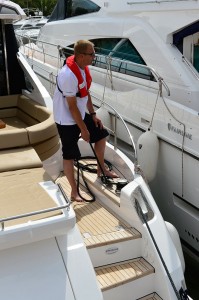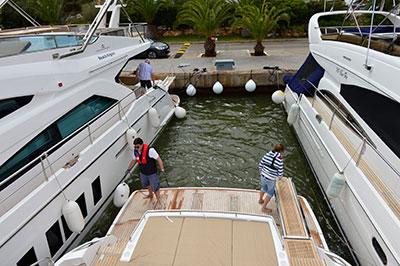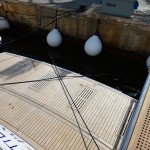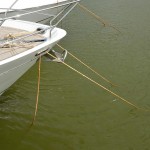Stern-to Berthing
Newsletter ArticlesStern-to berthing is typical in many non-tidal harbours, it just means that more boats can be accommodated in a small area without pontoons and not much has to be provided by the harbour itself. In its simplest form you drop your anchor a good distance out, reverse up to the quay wall and attach your stern lines, then pull in on the anchor rode to get the boat positioned correctly. This works well, but in a busy harbour untangling all the anchors later on can be a real pain, so many harbours add an improvement and lay a big chain anchored to the sea bed with individual lines to attach to your bows. This keeps things simple and with extra quay walls you can get even more boats in. These ready laid bowlines are taken back to the quay wall with a lighter line called a lazy line, this is the one you collect and take forward after the sterns are attached.
To berth in a harbour with lazy lines you need some preparation work, prepare your fenders both sides and much higher that with a pontoon system, as you may well be pushing between your neighbours to actually create the space that will be your berth. You will need a pair of stern lines, now check which direction the wind is coming form, wind on the stern is easiest, a cross wind more difficult and a wind on the bow on a boat without a bow thruster can be quite hard work. The best position for the approach is stern first approaching your intended berth ready to reverse into your spot. In more crowded harbours with several quays this may mean helming up an aisle just like a pontoon marina, if there is a crosswind try to approach with the wind on the stern. Bring the boat to almost a halt when you are level with your berth, now spin the boat slowly to get it lined up and then reverse in. Keep the speed slow, when you have half of the boat in the space the boats either side will help hold it all steady, as the stern nears the dock the crew can attach the stern lines. Always do the windward line first, then the leeward line, now collect the lazy line from the dock wall, take it forward outside everything on the boat, it runs along the seabed under the boat to a thicker line which is anchored to the sea bed, pull this up tight enough to keep the boat off the quay. It’s nicknamed the ‘slime line’ for good reason so gloves are great.
 A strong crosswind may allow other boats to push across your berth, best plan here is to reverse up to the windward boat with a big fender positioned on the quarter, now you can lean very gently against the other boat to create the space needed.
A strong crosswind may allow other boats to push across your berth, best plan here is to reverse up to the windward boat with a big fender positioned on the quarter, now you can lean very gently against the other boat to create the space needed.
To achieve a berth in a harbour which requires you to drop your anchor and reverse in, line up your boat stern to the quay, start reversing slowly, now drop the anchor when roughly 4 boat lengths away and keep the boat gently moving astern. About a boat lengths from the quay, snub the anchor to ensure you have a bite, then continue to let it out slowly whilst still reversing until you are close enough for the stern lines. If there is a crosswind then you will need to drop your anchor slightly upwind of your berth so that it keeps the bow up to windward whilst you reverse in. Get the plan ready with the crew before you start to anchor as it’s hard to communicate above the noise of the winch and never try to free a chain jam with fingers.
Top Tips
- Once lined up be nice and gentle on the power.
- Bow and stern thrusters really help but remember the boat will pivot around the centre, so small bursts are best.
- First line on should always be the windward line.
- Always leave some slack on the stern lines until the bowline is attached.
- Cross springs on the stern are great and help to keep your boat square.
- In an offshore wind keep the stern lines tighter.
- In an onshore wind keep the bow lines tighter.
- Remember to leave a bit of slack to deal with any swell.




